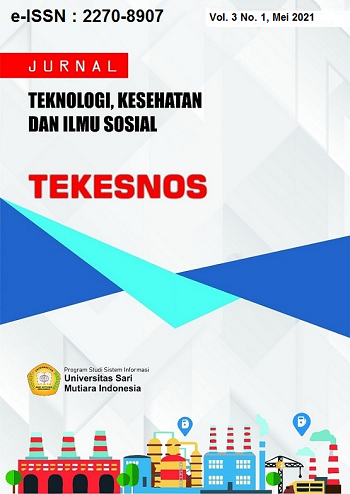IDENTIFIKASI SIMPLISIA DAN UJI AKTIVITAS ANTIBAKTERI EKSTRAK ETANOL DAUN SAWO (Manilkara zapota L) TERHADAP PERTUMBUHAN BAKTERI Staphylococcus aureus
Keywords:
Antibacterial, Ethanol Extract, Manilkara zapota, staphylococus aureusAbstract
Sawo (Manilkara zapota) is a fruit plant that belongs to the Sapotaceae family. Sapodilla plants are tropical plants that are easily adaptable to various temperatures, rainfall, soil, and soil salinity. This plant has been widely cultivated and used traditionally as medicine. Sapodilla plants are widely cultivated in yards, gardens and are very easy to find in the market. Staphylococcus aureus bacteria are gram positive bacteria, immobile, not spore-forming and capable of forming capsules, cocci-shaped and arranged like grapes, one of the causes of diarrhea is Staphylococcus aureus bacteria. To overcome this disease by providing antimicrobial agents of natural origin that can inhibit the growth of these bacteria. This study was conducted with the aim of knowing the antibacterial activity of the ethanol extract of rambutan seeds with concentrations of 45%, 50%, 55% and 60% against the growth of Staphylococcus aureus bacteria. This research method uses an experimental method, namely to determine the antibacterial activity of ethanol extract from sapodilla leaves against the growth of Staphylococcus aureus bacteria. This research used 96% ethanol as solvent. The test was carried out through several stages including material collection, preparation of simplicia, manufacture of ethanol extract from sapodilla leaf simplicia by maceration and testing of antibacterial activity against Staphylococcus aureus bacteria. Based on the identification of sapodilla leaf simplicia powder, there are trichomes or hair coverings, stomata and calcium oxalate crystals. Phytochemical screening test of the thick extract of sapodilla leaves contains a group of alkaloid compounds, flavonoids, saponins, steroids/triterpenoids and tannins. The results of the antibacterial activity test of sapodilla leaf extract against Staphylococus aureus bacteria had an average inhibitory activity at concentrations of 45% (9.4 mm), 50% (12.2 mm), 55% (14.8 mm) and 60% (16.3mm). As a comparison, Cloramfenocol 30 g was used to produce an inhibitory power of 20,18 mm and the best results obtained were at a concentration of 60% which had an inhibitory power of 16.3 mm
Downloads
References
Adelberg, Jawetz & Melnick. 2017. Mikrobiologi Kedokteran, Jawetz, Melnick, & Adelberg, Ed.23, Translation of Jawetz, Melnick, and Adelberg’s Medical Microbiology, 23thEd. Alih bahasa oleh Hartanto H, et. al. Jakarta: EGC. Halaman 219.
Amin, dkk., 2014. Kekayaan Alan Indonesia. Departemen Pertanian, Fakultas Pertanian UGM. Halaman 19-26
Ali, S. M., Pervaiz, A., Afzal, B., Hamid, N., & Yasmin, A. 2014. Open Dumping Of Municipal Solid Waste And Its Hazardous Impacts On Soil And Vegetation Diversity At Waste Dumping Sites Of Islamabad City. Journal of King Saud University-Science, 26(1): 59-65.
Anggraini, Ikatanti, Ratna. 2017. Kemampuan Inhibisi Ekstrak Daun Kopi Robusta (Coffea canephora) Menggunakan Pelarut Etanol terhadap Pertumbuhan Lactobacillus acidophilus. Skripsi. Universitas Jember.
Arulanantham, R., Pathmanathan, S., Ravimannan, N., Niranjan, K. 2014. Alternative culture Media for Bacterial Growth Using Different Formulation of Protein Sources. Annals of Biological Research, 5(1):36- 39.
Azizah, D. N., K. Endang & F. Fahrauk. 2014. Penetapan Kadar Flavonoid Metode AlCl3 Pada Ekstrak Metanol Kulit Buah Kakao (Theobroma cacao L.). Jurnal Ilmiah Farmasi. 2 (2) : 45-49..
Brook,et.al, 2007. Microbiological Aplications Laboratory Manual in General Microbiology. New York: Mc Graw-Hill. Hal. 122.
Cappucino, J.G., Shema, N. 2014. Manual Laboratorium Mikrobiologi. Jakarta: EGC. Hal: 691-694.
Dalimarta, 2013. Tanaman Obat Tradisional Indonesia. Jakarta: Raja Grafindo Persada. Halaman 79-86.
Ditjen POM. 1979. Farmakope Indonesia Edisi Ke III. Jakarta: Departemen Kesehatan Republik Indonesia.
Ditjen POM. 1995. Farmakope Indonesia Edisi Ke IV. Jakarta: Departemen Kesehatan Republik Indonesia. Halaman 55-64.
Fifendy, Mades., M. Biomed. 2017. Mikrobiologi Edisi Pertama. Kencana. Depok. Halaman 55-65.
Gandjar, Indrawati, Wellyzar, S. 2006. Mikrobiologi Dasar dan Terapan. Jakarta: Yayasan Obor Indonesia. Halaman 87-90.
Jawetz, Melnick, and Adelberg’s Medical Microbiology, 23thEd. Alih bahasa oleh Hartanto H, et. al. Jakarta: EGC. Halaman 219-233.
Jutono, J., Soedarsono, S., Hartadi, S., Kabirun S., Suhadi D. 1980. Pedoman Praktikum Mikrobiologi Umum. Yogyakarta: Departemen Mikrobiologi Fakultas Pertanian UGM. Halaman 29-32
Kementrian Kesehatan Republik Indonesia. 2014. Farmakope Indonesia Edisi Ke V. Jakarta: Kementrian Kesehatan Republik Indonesia. Halaman 904.
Lay, B. W., Sugiyo, H. 1994. Analisis Mikroba di Laboratorium. Jakarta: Raja Grafindo Persada. Halaman 34, 72, 73.
Martyniuk, Stefan O., & Jadwiga. 2011. Use of Potato Extract Broth for Culturing Root-nodule Bacteria. Polish Journal of Microbiology, 60(4): 323-327.
Puspaningtyas, 2013. Tanaman Sawo dan Manfaatnya Bagi Kesehatan. Jurnal of Nutrition College, 4(2): 585-592.
Prasad et al., 2008. Pengantar Bakteriologi Dasar. Malang: Intimedia. Halaman 18-20.
Sebayang, 2010. Tanaman Asli Indonesia. Jakarta: Raja Grafindo Persada. Halaman 51-55.
Soegiharjo, C. J. 2013. Farmakognosi. Citra Aji Parama. Yogyakarta













